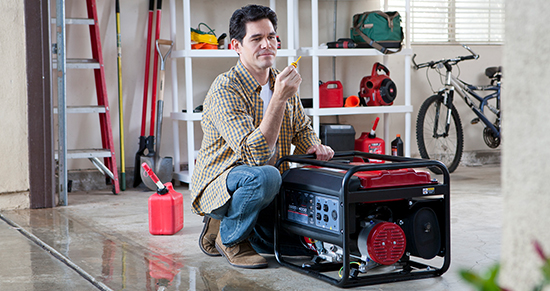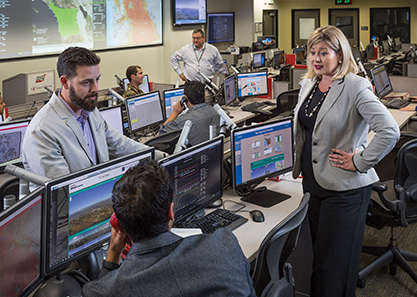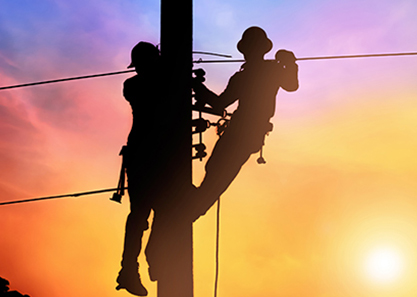Get alerts
In the event of a Public Safety Power Shutoff, do we have your current contact information and have you signed up for outage notifications?
Electric generator safety
A backup electric generator can be an valuable thing to have when the power goes out. Find out whether you need one for your home, how to shop for the right generator and use it properly to avoid risking you and your family’s safety.


Portable generators are designed to provide temporary power for basic needs. They can range in price from a few hundred dollars to more than $1,000. It is extremely important to determine what size generator you will need and how to operate it safely before running it for the first time.

Permanent standby generators are bigger and better equipped to power larger structures, such as an entire home, if sized properly. When a power outage occurs, they turn on automatically and turn off when power is restored. These generators require professional installation from a licensed electrician.
All generators installed with an Auto Transfer Switch require a Backup Generator Application submitted to SDG&E for review and approval.
Power outages can happen at any time, sometimes lasting for a few hours or days at a time. A backup generator is your own personal electrical power source.
Backup generators aren’t for everyone. They can be loud when running, costly, require regular maintenance and can result in safety hazards if used improperly. Keep this in mind alongside your electric needs.
If you meet the criteria outlined below, consider getting a backup generator for your home. Don’t wait for an emergency to occur to determine whether you’re reliant on a steady stream of power.
- Medical Needs
Are you dependent on electricity for a medical device, such as assistive technology, breathing machines, a power wheelchair or scooter, home oxygen or dialysis? Do your medicines have to be refrigerated?
- Safety
Planned and unplanned power outages are always a possibility. Do you live in an area with frequent or lengthy power outages? What about a high-risk climate area? Some communities are more vulnerable to weather-related outages.
- Comfort
The decision to purchase a generator is entirely personal in some cases. Are your children afraid of the dark? You may decide you don’t want to be inconvenienced by a power outage and keep the essentials on to provide household comfort.
- Energy Needs
How many appliances will you want to run in a power outage? What kind of appliances are they? Small or large? Are there any older people in your home who use a stairlift? You’ll figure how much power you need by adding the amount of wattage on each item that you need powered.
- Fuel Source
You can choose battery, natural gas, gasoline, propane, diesel fuel and solar with back-up storage.
- Installation
Consider whether you need a portable generator or a standby generator. Does your backup generator need to be easily moved around? Then a portable generator may be right for you. Or if you lose power and need energy to switch immediately, a standby generator can start up in a matter of seconds and might the right option for your needs. A standby generator needs to be installed by a certified, licensed electrician.
- Work with a licensed electrician. Professionals will make sure local, state and national regulations are adhered to when installing the generator and that the generator works properly so it can deliver power when required.
- Store your generator outside in a dry location.
- Avoid running your generator in the rain. Make sure it’s covered properly and well ventilated.
- Never plug your generator into any electric outlet in your home or business. This is known as back-feeding and it can be extremely dangerous for you, your neighbors and utility workers that may be working on power lines.
- Read all manufacturer instructions. Make sure you understand them and follow all instructions on properly “grounding” your portable generator.
- Turn off a gas-powered generator for at least five minutes before refueling to allow it to cool and avoid risk of fire.
- Keep extension cords out of the way so they don’t present a tripping hazard.
- If you’re using a gas-powered generator, stock up on extra gasoline and store it in a cool, well-ventilated location – preferably outside your home or business and away from sources of heat.
- Always run your generator at least 20 feet from your home or business and make sure the exhaust is being directed away from your location.
- Ensure the electric load never exceeds the manufacturer’s rating.
- Never refuel a generator while it is running or hot.
- Periodically run the generator to ensure it will start and run properly.
- Know how to shut off the generator in case of emergency.
- Always have a fully charged, approved fire extinguisher located near the generator.
- Keep children and pets away from generators at all times to avoid injury.
- Operate the generator only on level surfaces and where it will not be exposed to excessive moisture, dirt, dust or corrosive vapors.
- Allow at least five feet of clearance on all sides of the generator when operating.
- Do not overfill the fuel tank. Always allow room for fuel expansion.
- Do not smoke near fuel or generator.
- It is recommended that you install battery operated carbon monoxide alarms/detectors indoors according to manufacturer’s instructions/recommendations.
Portable battery power stations
- Portable power stations are like a normal household outlet and should be used carefully like any outlet in your home.
- Read all manufacturer instructions. Make sure you understand them and follow all usage and safety instructions before operating any portable battery.
- Observe all input/output connection and extension cord ratings to avoid fire or electrical shock.
- Use in a ventilated area and do not obstruct fan openings on the unit. Power supplies will get hot when in use.
- Do not plug in high usage devices that may quickly drain or even damage your battery (e.g. portable heaters, hair dryers, vacuum cleaners, etc.).
- Do not charge immediately after use. Wait for the unit to cool down.
- Avoid contact with liquids of any kind. Do not operate in wet conditions such as rain or high humidity. Keep your unit clean and dry.
- Do not insert foreign objects into outputs or ventilation.
- Do not dissemble, pierce or otherwise damage power stations or batteries as this may invalidate warranties and may cause them to catch fire or explode.
- Follow local, state and federal regulations and contact a local battery recycling center for proper disposal.
- Do not run extension cords under rugs, carpets or doors where heat can be generated, or a cord may be damaged.
- Ensure replacement batteries and chargers are designed and approved for use with specific devices, and purchase from the device’s manufacturer or an authorized reseller.
- Remove lithium-powered devices and batteries from chargers when they are fully charged.
SDG&E is committed to helping customers, especially those in the high threat fire district (HFTD), in the event of a Public Safety Power Shutoff (PSPS). SDG&E offers backup power solutions to qualifying customers that can help power your home during a PSPS outage.
Personalized resiliency resources
SDG&E wants to help you prepare for PSPS events and other outages. With you in mind, we’ve developed a brief series of questions to help ensure your resiliency during power outages. Our personalized resiliency resources include emergency & vehicle supply lists, local community material and information on backup power solutions. You will also have the opportunity to provide us with feedback on your additional needs and how SDG&E can help you prepare for emergency planning.
Generator Assistance Program
SDG&E’s Generator Assistance Program eligibility requirements (must satisfy all to qualify):
- You must have an active SDG&E account.
- You must reside in Tier 2 or 3 high fire threat districts, as determined by the CPUC on the HFTD Map.
- You must have experienced a PSPS event in the past 3 years.
- Selected portable generator must be on the SDG&E Qualified Product List.
Interested customers who meet eligibility requirements can learn more here.
Public Safety Power Shutoffs
As a last resort, we might need to shut off your electricity for public safety.
Power outage safety
Learn more about when we turn off power to protect public safety and the steps we take to restore power afterwards.


